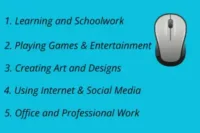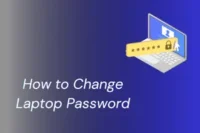How to Use a Mouse & Keyboard – Boost Your Computer Skills
Published: 29 Mar 2025
Have you ever wondered if you’re using your mouse and keyboard correctly? It’s easy to think everyone knows how to use these essential tools, but you’d be shocked how many people don’t fully take advantage of their features. Whether you’re new to computers or want to enhance your efficiency, understanding how to use a mouse and keyboard properly can make a huge difference in your daily tasks. Let’s dive into the tips and tricks to ensure you’re getting the most out of them.
1. How to Use a Mouse: Step-by-Step
Follow these simple steps to master the basics and enhance your computer experience.
Holding the Mouse Correctly
First, proper hand placement is key to ensuring comfort and avoiding strain. When using the mouse:
- Rest your hand gently on the mouse.
- Your fingers should set naturally on the left and right buttons.
- Keep your wrist neutral (not too bent) to prevent pain over time.
If you use a wireless mouse, consider investing in one with an ergonomic design. This can help reduce wrist strain and enhance comfort during long sessions.
Basic Mouse Functions
To navigate your computer with ease, understanding how to use the mouse effectively is essential. Below are the most common mouse functions, broken down to help you move around your screen effortlessly.
Left Click
The most frequently used button. It’s used to select, open, or activate items on your screen.
Example: A single click selects a file or a folder, while double-clicking opens it.
Right Click
This button opens up a menu with additional options related to the item you clicked.
Example: Right-clicking on a folder gives you options like “Open,” “Rename,” or “Delete.”
Scroll Wheel
The scroll wheel lets you move up and down through long documents or webpages.
Tip: Hold down the Ctrl key while scrolling to zoom in and out on webpages.

Advanced Mouse Features (Optional)
If you have a mouse with extra buttons or adjustable settings, you can further enhance your experience:
Extra Buttons: Many mice come with customizable buttons, which can be mapped to functions you use often, like copy or paste.
Adjusting Sensitivity (DPI): The DPI (dots per inch) setting controls the cursor’s speed. Higher DPI settings make the cursor move faster and are useful for precision tasks like graphic design or gaming.
2. How to Use Keyboard: Step-by-Step
The keyboard is another necessary tool for interacting with your computer. Although typing may be its primary use, your keyboard can do much more than input letters and numbers.
Correct Hand Placement for Typing
Proper finger positioning is important for speed and accuracy. Here’s a simple guide for the home row keys:
- Left Hand: Place your fingers on A, S, D, F.
- Right Hand: Place your fingers on J, K, L, ;.
This position allows you to type faster without looking at the keyboard.

Also Read:
Common Keys You Should Know
The keyboard is filled with several keys that help speed up your work. Here are some of the essential ones:
Alphabetic Keys: These are your standard A-Z keys for typing letters.
Spacebar: Press this large key in the middle to add spaces between words.
Enter: Use it to move to the next line or confirm commands.
Backspace/Delete: These keys remove characters or delete items from your screen.
Must-Know Keyboard Shortcuts
One of the most effective ways to increase productivity is by learning keyboard shortcuts. Here are a few of the most useful ones that can save you lots of time:
- Ctrl + C: Copy selected text or items
- Ctrl + V: Paste copied items
- Ctrl + X: Cut selected text or items
- Ctrl + Z: Undo the last action
- Ctrl + S: Save your work
- Alt + Tab: Switch between open programs or windows
Combining the Mouse and Keyboard for Maximum Efficiency
One of the best ways to improve your efficiency is by using both the mouse and keyboard together. This can save you a lot of time and effort when completing tasks on the computer.
Multitask Like a Pro
Here’s how you can combine the use of both devices:
Use the mouse to select and navigate through options, like clicking buttons or opening folders.
Use keyboard shortcuts to perform actions quickly, such as Ctrl + C (copy) or Ctrl + Z (undo).
For example, while working on a document, use the mouse to highlight the text you want to copy, then quickly hit Ctrl + C to copy it, and Ctrl + V to paste it. This combo speeds up your workflow and reduces the time spent switching between the devices.
Troubleshooting Mouse and Keyboard Issues
Even the best equipment can sometimes face problems. If you run into issues with your mouse or keyboard, here are some quick troubleshooting tips.
If Your Mouse Stops Working:
Check the Connection: Ensure the mouse is plugged in or the wireless receiver is connected.
Try a Different USB Port: Plug it into a different port to rule out the possibility of a faulty port.
Replace the Batteries: If using a wireless mouse, check if the battery is low or replace it.
If Your Keyboard Isn’t Typing:
Check for Sticky Keys: Sometimes, keys can get physically stuck. Make sure no keys are jammed.
Reconnect the Keyboard: If it’s a wired keyboard, unplug it and reconnect it. For wireless keyboards, make sure the batteries are fresh or fully charged.
Restart the Computer: A simple restart can sometimes resolve unresponsive peripherals.
Conclusion
You’ll be able to do work quickly, accurately, and comfortably after you understand how to use the mouse and keyboard effectively. By focusing on proper hand placement, mastering keyboard shortcuts, and using the mouse and keyboard together, you’ll significantly improve your computer experience.
Don’t forget to practice regularly to improve your muscle memory and quickness. When you get the hang of it, using both devices will become second nature, and your productivity will skyrocket.

- Be Respectful
- Stay Relevant
- Stay Positive
- True Feedback
- Encourage Discussion
- Avoid Spamming
- No Fake News
- Don't Copy-Paste
- No Personal Attacks



- Be Respectful
- Stay Relevant
- Stay Positive
- True Feedback
- Encourage Discussion
- Avoid Spamming
- No Fake News
- Don't Copy-Paste
- No Personal Attacks





